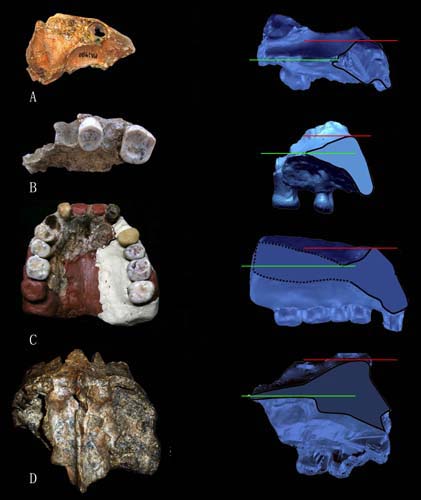Eastern Eurasian Archaic Humans Featured a Bi-level Nasal Floor as Seen in Neandertals
In an assessment of the nasal floor configurations of the available and sufficiently intact, if still incomplete, paleoanthropologists from Institute of Vertebrate Paleontology and Paleoanthropology (IVPP), Chinese Academy of Sciences, Washington University and University of Missouri, found that archaic Homo maxillae from eastern Eurasia seem to have a prevalence of the bi-level pattern similar to that seen in the western Eurasian Neandertals, while early modern humans from eastern Eurasia mostly exhibit the level floor pattern predominant among early and recent modern human populations, indicating that bi-level nasal floors were common among Pleistocene archaic humans, and a high frequency of them is not distinctive of the Neandertals as thought before. Researchers reported online 21 September 2012 in the scientific journal of Anthropological Science.
A bi-level nasal floor, although present in most Pleistocene and recent human samples, reaches its highest frequency among the western Eurasian Neandertals and has been considered a feature distinctive of them. Early modern humans, in contrast, tend to feature a level (or sloping) nasal floor.
“Sufficiently intact maxillae are rare among eastern Eurasian Pleistocene humans, but several fossils provide nasal floor configurations”, said WU Xiujie of the IVPP, first author of the study, “Of the four observable eastern Eurasian archaic Homo maxillae (Sangiran 4, Chaoxian 1, Xujiayao 1, and Changyang 1), three have the bi-level pattern and the fourth is scored as bi-level/sloping. It therefore appears that bi-level nasal floors were common among Pleistocene archaic humans, and a high frequency of them is not distinctive of the Neandertals”.
The dominance of bi-level and sloping nasal floors among the earlier, eastern Eurasian archaic human specimens could reflect unusual sampling of archaic populations possessing similar distributions of level and sloping configurations as seen in recent modern humans. However, the taphonomic probability of exclusively recovering specimens with inferiorly displaced nasal floors from populations characterized by a preponderance of level configurations is likely small.
“If these eastern Eurasian archaic specimens are in fact representative of populations principally characterized by depressed nasal floors, then the dominance of the bi-level (and sloping) nasal floors in eastern Eurasian archaic humans would parallel that present in the (much larger) sample of Neandertals”, said coauthor Scott Maddux, Department of Pathology and Anatomical Sciences, University of Missouri, Columbia.
The configurations of these eastern archaic maxillae, however, need not imply close affinities to the western Eurasian Neandertals. For example, several features of the nasomaxillary region have been shown to scale allometrically with overall facial size, both in recent humans and across Homo. Accordingly, the prevalence of depressed nasal floors in these two archaic Eurasian samples may simply be related to by both populations possessing similarly sized (large) faces, as nasal floor morphology is correlated with several measures of facial size across Homo, especially facial height and width.
“The relationships between nasal floor morphology and other aspects of facial size and shape remain uncertain, and they are difficult to evaluate with the available and incomplete eastern Eurasian remains. However, these results are sufficient to question whether a high frequency of the bi-level pattern is a distinctive Neandertal feature and to query the phylogenetic and functional significance of this configuration”, said corresponding author Erik Trinkaus, Department of Anthropology, Washington University, St Louis.
This work has been supported by the Chinese Academy of Sciences, Wenner Gren Foundation, Leakey Foundation, University of Iowa, and Washington University.
Journal reference: Anthropological Science, DOI: 10.1537/ase.120709

Fig.1 Nasal floor profiles for the four eastern Eurasian archaic Homo specimens: Xujiayao 1 (A), Changyang 1 (B), Chaoxian 1 (C), and Sangiran 4 (D). (Image by WU Xiujie)
Download attachments: